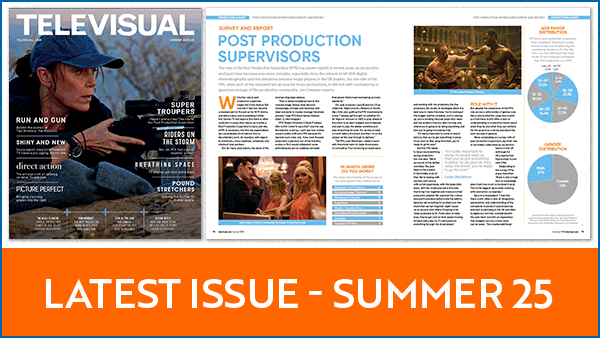Robin Robin is the next animated Christmas special vying for a place on the seasonal classics list. Jon creamer reports.
There is a long tradition of animated Christmas specials that have become a much-loved part of the ritual of the season.
Robin Robin, the story of an orphaned bird adopted by a family of burglar mice who embarks on a dangerous festive food raid, hopes to take its position among the exalted few.
The 30-minute Christmas special from Aardman for Netflix is not just the studio’s first stop-motion musical, but makes a departure from what most see as the ‘Aardman style’ made famous by Wallace and Gromit and Shaun the Sheep.
The story begins when directors Dan Ojari and Mikey Please took the kernel of their idea, rendered in story book form, to the Annecy Animation Festival in 2018. A chance meeting with Aardman executive creative director, Sarah Cox, in the canteen led to the pair giving her an ad hoc performance of the show’s songs “to the background sound of people chewing their lasagne,” says Please. Luckily “she was as excited by the idea as we were.”
After a period of development at Aardman, “to make sure that we had a clearer pitch,” says Ojari, it was presented to Netflix. “Again it went down really well. Surprisingly to us, they were as enthusiastic as us and Sarah.”
And then the hard work began, particularly drilling down further into the characters and story. “That opening situation of a bird brought up by a family of mice, the theme of feeling different and trying to fit in and that difference is a wonderful thing, those themes are still there,” says Ojari. “It feels like the same project, but it’s changed wildly” over time.
The character design, world design and animation then entered a long research and development stage. “It’s a slight departure from the traditional Aardman style,” says Please, particularly the directors’ use of needle felt. “Some of that came from the body of work that we’d done before and some of it was a new exploration that no one had tried out before.” Luckily, says Please, “there was such an appetite to embrace new things from the team that it never felt too much of a challenge.”
Ojari says the material is “very tactile. There is something intrinsically endearing about the look of something rendered in needle felt. It felt like a strong way to render the main characters of the film.”
The material has other qualities too. “In stop motion, fabric is the one thing that still, on camera, looks really, really real no matter how much you push the production value,” says Please. “It has a way of moving as though it’s living and breathing. That’s kind of where the magic is.” It also “lights beautifully. If you hit it from the back, it’s got a soft edge and it’s ever so slightly translucent. You can pick up this glow that on an opaque material might feel slightly flatter. There was something about the warmth and glow of the material that was thematically right.”
Says Ojari: “You can render characters and make them look like cg characters. That’s not a criticism. There are some brilliant uses of that. But you’re not going to celebrate the magic of it being a handmade thing that someone is manipulating. In the same way that plasticine has its fingerprints, needle felt has a little boil to it.”
Says producer, Helen Argo: “I’m not sure you could have done it in, perhaps, CG. That wouldn’t have done it justice. It has a real handcrafted look, and a lot of the effects were done in camera.” And that wasn’t easy. “The biggest challenge was that we worked in a number of different scales. And then we had to have sets to match those scales. But it’s nice to do effects in camera, because it spoke to the material that we’re working with.”
At 30-minutes, this is the biggest production the directors have taken on. But, they say, the production aspect wasn’t the biggest leap for them. “It was a massive production, but we were equipped for that,” says Ojari. “And Aardman have an amazingly organised and brilliant system, so it felt quite comfortable.”
The step up was rather “the level of craft behind figuring out how the story works, figuring out the characters in the story, working with the story team and the writing team and the musicians to convey that powerful character driven story,” says Ojari.
The production itself had been shooting for a just a few short weeks when lockdown struck but, say the directors, the hiatus may have been no bad thing. “It meant that because we’d shot a bit, we knew what it was looking like,” says Ojari. “We just carried on working through the pandemic with our edit and story team on making the animatic and the story better.”
When production kicked off again, social distancing meant fewer sets running at the same time, which “meant that we had to shoot at a slower rate. That gives you more headspace,” says Please. The pair say they’ve suggested a similar set up for production in the future, pandemic or no pandemic but, “we’ve yet to hear back on how that’s going to go down.”
DETAILS
Broadcaster Netflix
Produced by Aardman
Directors Dan Ojari, Mikey Please
Executive producer Sarah Cox
Producer Helen Argo
Voice cast Richard E Grant, Gillian Anderson, Adeel Akhtar, Bronte Carmichael
Chief animator Ian Whitlock
Head of puppet making Anne King
DOP Dave Alex Riddett
Floor manager Richard Bowen
Music Ben Please and Beth Porter, AKA The Bookshop Band
This article first appeared in the Winter issue of Televisual Magazine
Jon Creamer
Share this story


















